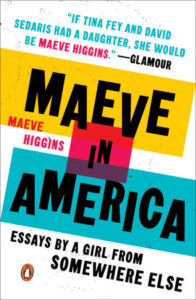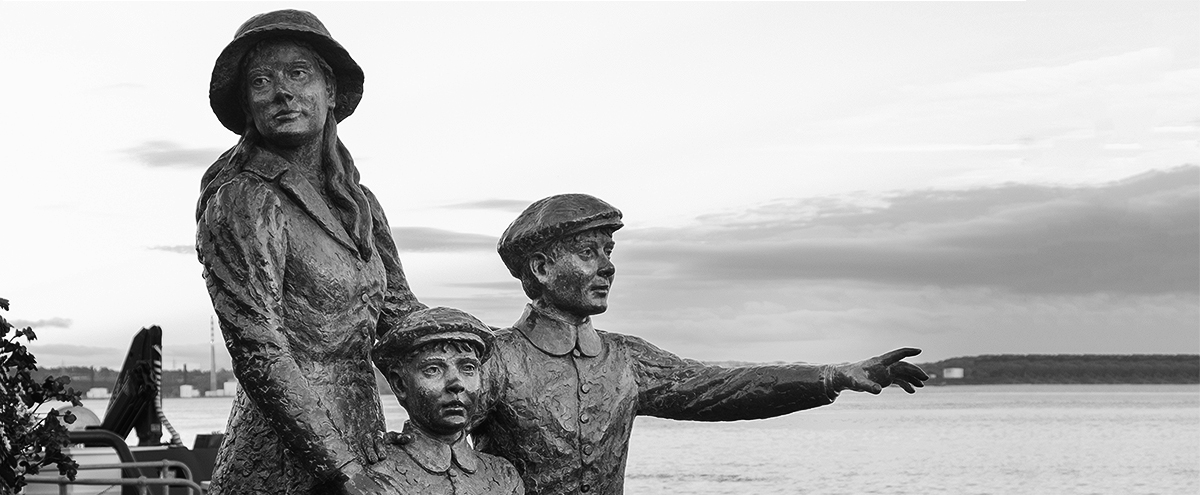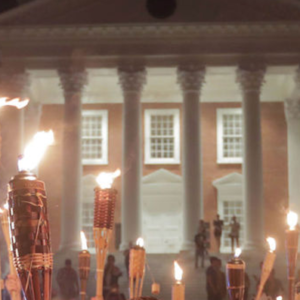But back to what would become the biggest annual event in Irish America’s calendar. When the very first Saint Patrick’s Day parade happened in 1762, I was but four years old. It sounds like it was a fun event. There were just a few Irish soldiers serving in the British army, and they realized that here in America they were permitted to wear green, and sing songs in Irish, and generally have a good time doing stuff they weren’t allowed to do back home, so they paraded around for a while, playing the pipes. In later years, the aforementioned Ancient Order of Hibernians took over the running, and to this day they lead the parade, albeit now under a different name. Those were the people I tried to talk to, and that’s how I discovered that trying to talk to an ancient order of anything is tough. Reaching the Fifth Avenue parade committee was tricky, but someone finally answered the phone. They were having a function to honor their grand marshal, so I phoned their office to ask if I could go along to write about it. A voice replied, “Absolutely not.”
Having been shut down by the big parade, I took comfort in an invitation to the St. Pat’s for All celebration of their two grand marshals. It was hosted at home by the Irish consul general and a chubby black Labrador whose name I didn’t catch. One of that year’s grand marshals, Tom Duane, looked like a clean-shaven Santa, and chuckled like him too. He was elected to the state senate in 1998 and became the senate’s first openly gay and first openly HIV-positive member. Proud of his heritage—all four grandparents were Irish immigrants to America—Duane was arrested many times for protesting at the Fifth Avenue parade. He was among the first politicians to support Fay’s parade. It was fun to meet him at a time when the tide was turning firmly in his favor. “Now they’re all at it!” he said, a grin ruining the credibility of his attempted eye-roll.
The other grand marshal was Terry McGovern, a softly spoken human rights lawyer with copper-colored hair. In a short speech she honored her mother, who was killed at the World Trade Center on September 11, saying that her mother was the first person to introduce her to the concept of human rights. Then a man pulled out his violin; he looked like an extra from The Sopranos, but he played like an angel, specifically an angel from Sligo. He closed his eyes as the notes of the reel whirled and slipped through the assembled crowd and we whooped and tapped, the city glittering beneath us.
This right here was a version of an Irish America I felt at home in. Annie Moore had married a German man, and, while she stayed close to her family throughout her life, she lived in one of the most multiethnic neighborhoods in the country. I wondered how she defined her identity, if she ever had time to consider it. Annie certainly never had the option to return to Ireland, so, like many an immigrant to this day, she had to figure out ways to make the U.S. feel like home.
I’m very lucky to get that chance to feel at home here, and even luckier to go back and forth freely between the two countries. For most people around the world, America is a fortress. Forget about moving here; for huge swaths of the global population it is impossible even to visit. Visas to the U.S. are, as a gym instructor once said when I tried to do a burpee, “extremely challenging and likely not possible.” I’m not even on an immigrant visa: I’m on a non-immigrant visa, which is still very difficult to get. Before my P-3 visa expired I applied for an O-1 visa, which is, by design, only available to the privileged few. To secure it you have to already be a celebrated individual, or at least have the means to make it seem that way.
There’s an O-1A, for individuals with an extraordinary ability in the sciences, education, business, or athletics. Nobel Prize winners, Olympians, Fields medalists—these are the ones who come through on the O-1A. The O-1B is for individuals with an extraordinary ability in the arts or extraordinary achievement in the motion picture or television industry; and that’s me! Having been on a TV prank show in Ireland and winning an award for it, I can honestly claim that I have an extraordinary ability in the arts. That wasn’t the only thing I needed. As part of my application, I also had to collect testimonials from recognized experts in my field. Testimonials are garnered by asking people to vouch for you, in writing, to the Department of Homeland Security. Not just anybody; they must be supremely successful and way above you on the show business scale of one (me) to a thousand (Diana Ross).
These testimonials are known as “the Twelve Letters,” and gathering them is a mortifying process for anyone remotely insecure about their worth as a person and an artist. You may run into some psychic trouble if you are, say, a woman, or an Irish person, or a person who was raised Catholic. Immigration lawyers come up with sample letters, and these letters are brimful of hyperbole. They have to be, to convince the officer in charge of your case that you are indeed an alien of extraordinary ability. Words like “magnificent,” “peerless,” and “transcendent” are encouraged. My advice to anyone collecting these is to consider taking regular doses of cocaine throughout the process; this will give you the false confidence necessary. If you’re not comfortable with that, you will need at least a shot of testosterone in the mornings for the two to three weeks it takes to finish the application.
“I’m very lucky to get that chance to feel at home here, and even luckier to go back and forth freely between the two countries. For most people around the world, America is a fortress.”My extraordinary ability is doing stand-up comedy, carrying out prizewinning pranks, and persuading friends who do voice-overs in cartoons to write letters to the U.S. Citizenship and Immigration Services, telling them what an absolute legend I am. There are scientists in India and filmmakers in Colombia and orphans in Jordanian refugee camps, all trying to get to America, and I’m on my second O-1B visa, which will last me for three more years, after which I can apply for an extension. The question “Why me, and why not them?” has no satisfactory answer.
Annie Moore, that first immigrant through the gates of Ellis Island, never had any papers. She did not have a passport or a visa, and white immigrants did not need them back then. Chinese people were not so fortunate, having largely been banned from immigrating to America ten years earlier. Annie was an undocumented, unaccompanied minor, and she sailed right in. She was greeted with fanfare by the U.S. authorities, who gave her a gold coin to commemorate the occasion, then she was allowed to go and meet her parents, wholeheartedly encouraged to establish herself as a new American.
I think about Annie and me, both of us existing in the exact right set of circumstances to allow our lives in America to happen. We arrived at just the right time with the right qualifications. In her case she was young and healthy and white. Same here, with the addition of a favored career and good connections. I think about the people who were simply born in America, who just arrived on this planet in this coveted little corner, who have never had to consider leaving. I think too about the people who die trying to get here, like my producer Erika’s uncle, who suffocated in a container on a ship when he was just 20 years old, the eldest son of 18 children, the one who was supposed to send for the others in Colombia once he’d made a life for himself here. And I can’t fathom what it must be like for the people who have lived here since childhood, who are American in every way save their papers, but have no claim on the place, no path to citizenship. I mean, the sheer dumb luck involved in it all!
There’s a heartbreaking part of his autobiography My Bondage and My Freedom where Douglass recounts his time in Ireland and writes about being treated with dignity, treated just like anyone else, really, and what that meant to him as a former enslaved person. “Instead of the bright, blue sky of America, I am covered with the soft, grey fog of the Emerald Isle. I breathe, and lo! The chattel becomes a man.” And yet, back home in the U.S., many, though not all, Irish-Americans and their leaders opposed Douglass’s fight to end slavery and gain rights for African-Americans.
A book called How the Irish Became White is a tough read for those of us harboring any illusions that the Irish struggle for autonomy may have translated to support for black America’s struggle for justice. It chronicles the earliest days of Irish immigration, when the newly arrived Irish were in the same social and economic class as the free black Americans of the North. They already competed for jobs, and an end to slavery would heighten that competition. Like most immigrants, the Irish wanted to assimilate as quickly as possible, and soon realized that they had what we now know as white privilege, like in the labor movement where they rose to power, a movement African-Americans were excluded from. It’s a tragic and all-too-human story of how one group of oppressed people learned to collaborate in the oppression of another in order to get ahead themselves.
It’s also a story rarely told, at least among ourselves.
I’ve certainly heard a lot more about how hard the Irish had it, about our particular struggle, than about how, despite our own experience and despite consistent pleas from people like Daniel O’Connell back home to support the abolitionists, the Irish largely chose to identify simply as white, not Irish, not immigrant, in this new society where race meant everything. And the Irish definitely did have it rough, fleeing civil unrest and religious persecution, arriving to a new country that was often hostile to them because of their nationality. On Saint Patrick’s Day of 2017, with a White House full of Irish-Americans, that was the narrative on blast. Vice President Mike Pence spoke about his hardworking grandfather who left the Irish midlands to make a better life for his family in Chicago in the 1920s, attributing his family’s success to grit and spirit, failing to mention that the Irish were always in a better position in America than enslaved Africans and their descendants, freed or not, omitting the part where the Irish at that time leveraged their whiteness to ensure they were better off than Native Americans, and nonwhite immigrants too.
Being white in America is so potent, so seductive, it can blind a person without them knowing it. Being white can make a whole community forget who they are and where they came from. The year Frederick Douglass visited Ireland was the year the country began its terrible spiral into a famine that ultimately killed a million people. There had been food shortages before, and the extent of the disaster was not yet clear, but he writes in a letter of the horror of leaving his house and being confronted with the sight of hungry children begging on the street.
It’s painful to look through that lens at the present and see so many powerful Irish-Americans, like Paul Ryan, whose great-great-grandfather survived the famine and fled to America in 1851, doing everything they can to stop today’s refugees from entering the very country that gave their family sanctuary when they most needed it. That same Saint Patrick’s week that saw a celebration of Irishness in the White House also saw a potato head by the name of Mick Mulvaney, Trump’s budget director, with grandparents from Mayo, busily announcing cuts to international famine relief with a shamrock pinned to his suit, unaware of, or perhaps unconcerned with, just how grotesque that was.
“The Irish at that time leveraged their whiteness to ensure they were better off than Native Americans, and nonwhite immigrants too.”What else has happened in the 125 years since Annie Moore arrived? Well, the ban on Chinese immigrants has been lifted, and the ban on Muslim immigrants threatened and attempted, with some measure of “success.” Catholic churches are no longer being set alight by nativists, but synagogues and mosques are being vandalized by people on the same tip. In 2012 a Sikh temple in Wisconsin was targeted by a white supremacist who killed six people and wounded four. Nazis are on the streets and hate crimes are on the rise. A man whose own immigrant mother walked through the same Ellis Island doors as Annie campaigned for the presidency by slamming immigrants at every turn, and won. We’re hearing echoes so loud they’ve become the sound of today.
Echoes, of course, are still sounds in their own right. Those sounds never went away for some of us, for black people whose churches have been targeted with sickening consistency from the Civil Rights era right through to today. In 1963, the Ku Klux Klan bombed the 16th Street Baptist Church in Alabama, killing four little girls and injuring 22 other people. In 2015, a white supremacist named Dylann Roof hoped to start a “race war” by murdering nine black people in the Emanuel African Methodist Episcopal Church, a 200-year-old church that played an important role in the history of South Carolina throughout slavery, the Civil Rights movement, and the more recent Black Lives Matter movement. I used to think that the early days of immigration to the U.S. happened during a “different time,” but hatred unchecked has a way of collapsing time, trapping us all until we deal with it.
I still go home for the holidays. I call Ireland home, but America is my home too. In 2016 I stood on the darkening quayside in Cobh on Christmas Eve, and looked at a statue of Annie there. She is small and capable, her hands lightly resting on her little brothers’ shoulders, her eyes gazing back at a country she would never see again. An Irish naval ship had returned to the harbor earlier that week from its mission off the coast of Libya, a mission that rescued fifteen thousand people from the Mediterranean Sea in 2016, though that year was still the deadliest for migrants since World War II, with more than five thousand people drowning as they tried to find safety, or a better life.
On my flight home to New York after Christmas, I imagined meeting Annie today. I’d make a pot of tea and tell her how her family turned out so far. She never made it out of the city, but Megan Smolenyak Smolenyak tracked down her descendants. They are spread across the country: actors and doctors and financial consultants and stay-at-home parents, with Jewish and Latin and Asian blood mixed in with her own. Then I’d explain to her loudly and slowly how to follow me on Instagram, and maybe take a few selfies with that funny koala filter.
Annie Moore never made a fortune, or wrote a book, or invented a computer, and why should she? Why should immigrants be deemed extraordinary in order to deserve a place at the table? She did enough. She was just one woman who lived a short life, a hard one. She had 11 children, but only six made it through to adulthood. Can you even imagine burying five of your children? I can’t. I tuck that part away in the “she must have been different from me, with fewer feelings” folder, the delusional one that’s full of news stories from faraway places that are too terrible to bear. Annie died before she turned 50, but she lives on in every girl from a country shot through with rebellion and hunger, and in every immigrant who gives America their humanity, as every immigrant does.
A portion of this essay originally appeared in the January 1, 2017 issue of the New York Times.
__________________________________

From Maeve in America: Essays by a Girl from Somewhere Else. Used with permission of Penguin Books. Copyright © 2018 by Maeve Higgins.



